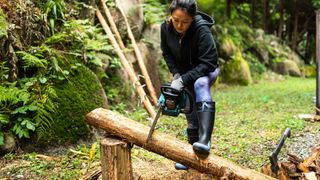We spoke to a chainsaw expert to get the lowdown on everything you need to know before buying and using your chainsaw. Thomas Goodman, a property and construction expert, says that “you should follow regular daily, weekly, and monthly maintenance checks to ensure you’re not missing anything important.” This will help keep your chainsaw in tip-top condition so that it’s always ready to be used. If you’re considering purchasing a chainsaw, don’t forget to check out our guide to the best chainsaws (opens in new tab) you can buy. We’ve included both gas and electric, and corded or cordless models, from brands including Kobalt, Greenworks and Remington.
How to put a chain on a chainsaw
Thomas Goodman gave us a step-by-step guide to starting a chainsaw.
1. Open access to the chain
“Use a wrench to unscrew the side plate nuts and remove the plate to gain access to the chain,” Thomas says. “If the chainsaw brake is attached to the side plate, be sure to unlock the brake before you remove the plate.
2. Release the chain from the tensioner
“Pull the nose of the bar away from the chainsaw to release it from the tensioner. The old chain should now be easily removable from the guide bar. Pull the drive links out of the guide bar.
3. Loosen the tension screw
“You will now need to locate the tension screw on the inside of the guide bar. This will need to be loosened a little bit to make it easier to install the new chain.
4. Thread your replacement chain
“Carefully thread the new chain around the clutch drum. Ensure that the drive links engage with the sprocket. Thread all of the drive links into the guide bar and around the nose.
5. Create tension
“When the chain is properly threaded along the clutch drum and the guide bar, add some tension by pulling the nose of the guide bar away from the chainsaw. Be sure to seat the guide bare on the saw’s adjustment pin when doing this.
6. Put the side plate back on
“Replace the side plate and screw the nuts back into place to hold it in position. However, don’t tighten the nuts all the way just yet. The guide bar needs to be able to move a little bit while the chain is tightened to the appropriate tension.
7. Adjust the tension, then tighten the side plate
“Use the tensioning screw to adjust the tension of the chain so that it is at the appropriate level of tension. Once you’ve done this, finish tightening the side plate nuts. Your new chain is now ready for use. Be sure to test it before putting it to work.” Thomas also gave us some tips about ensuring the chain stays on the chainsaw. “To ensure that your chain stays on the chainsaw, you will need to ensure that the tension is set correctly,” he adds. “When tensioning a chainsaw, begin by loosening the nuts on the side panel of the guide bar. This will provide enough room for the chain and bar to be adjusted. “In some cases, the brake is attached to the side panel. If yours is like this, be sure to unlock the brake before you remove the side panel. Next, you will need to adjust the tensioning screw. Tightening this screw will tighten the chain, and loosening it will loosen the chain. Double-check the chain and ensure that it is at the correct level of tightness before you move on. “Then, tighten the side panel nuts on the guide bar. It’s important that you lift the nose of the chainsaw when you tighten the nuts that secure the guide bar and side panel.”
How to maintain a chainsaw chain
Proper chainsaw maintenance is important not just for safety reasons, but to make it perform as efficiently as possibly. Goodman says there are checks you can do daily, weekly and monthly to ensure your machine is being properly maintained. • “For daily maintenance, test the trigger before use to ensure it is working properly, check all of the safety features and ensure the air filter is clean before each use,” he says. • “Inspect and turn the bar before each use for more even wear. Check the sprocket and replace it if it is visibly worn. Inspect the chain and sharpen it if needed. • “Check the tension on the chain and tighten it if needed. Check for damage on the starter and starter cord. Tighten any loose parts. • “Weekly, you should check the anti-vibration elements to ensure there is no wear and tear, lubricate the clutch drum bearings to prolong the life and performance of the clutch and inspect the bar for burrs and file them if needed. • “Remove and clean the spark plug, clean the flywheel fins on the starter and ensure the starter recoil spring is functioning properly. • “Also, clean the cooling fins on the cylinder to ensure proper cooling and heat distribution, clean the air box and carburetor and check the screen in the muffler and clean it or replace it if needed. • “Every month, you should check the chain brake band for cracks or weak spots and replace it if needed. • “Also monthly, inspect the clutch for wear and tear, examine the fuel filter and replace it if needed. • “Clean the outside of the carburetor, check all of the wiring, cables, and plugs to make sure everything is properly connected and clean the inside of the fuel tank.” Discover more guides for the garden… Best pressure washers (opens in new tab) Best leaf blowers (opens in new tab) Best patio heaters (opens in new tab)







